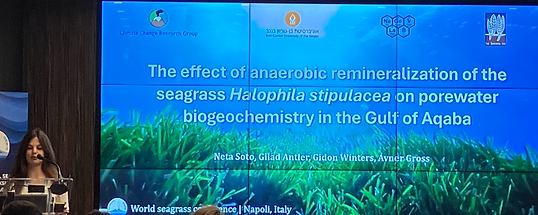


What is it ? The World Seagrass Conference 2024 (WSC2024) and 15th International Seagrass Biology Workshop, convened this time in Naples, Italy. The conference constitutes the "Olympics" of seagrass meetings. It is held every two years, each time in a different place in the world. This year's conference was the largest in the history of these conferences, with over 600 people from 48 different countries taking part (it should be remembered that the seagrass community is relatively small, much smaller for example than the communities of coral reefs or algae researchers).


Who went? The Dead Sea Arava Science Center’s name appeared in four different presentations, including presentations by Dr. Hung Nguyen (postdoc), Moran Kaminer (master student), Neta Soto (doctoral collaborative student) and Dr. Alice Rotini (Italian collaborator).
Why should we care? Awareness of the ecological importance of seagrasses is growing due to recent attention to their role in carbon sequestration as a potential “blue” carbon sink, as well as their role in nutrient cycling, sediment stabilization, pathogen filtration, and the formation of essential habitats for economically important marine species. Despite their importance and the increasing public and scientific awareness of seagrasses, simultaneous global (e.g., ocean warming, increase in frequency and severity of extreme events, introduction and spread of invasive species) and local (e.g., physical disturbances, eutrophication, and sedimentation) anthropogenic stressors continue to be the main causes behind the ongoing global decline of seagrass meadows. Degradation of seagrass ecosystems entails the loss of the associated biota, primary productivity, and local fisheries, and increased sediment re-suspension and beach erosion, processes that result in severe ecological and socio-economic consequences not only for seagrass meadows but also for neighbouring ecosystems and human inhabitants. How does the World Seagrass Conference fit in? The theme of WSC2024 and ISBW15, Seagrasses in the Anthropocene, comes from the knowledge that seagrass ecosystems face accelerating human pressure at local and global scales. Environmental changes are transforming seagrass ecosystems into new configurations unlike anything observed before. Returning to past configurations is no longer an option. The global challenge is establishing a new baseline, protecting, restoring, and rehabilitating the existing meadows. The key questions that were addressed in this meeting were: To what extent seagrass species are resilient to environmental changes? What are the mechanisms behind that? What can we do to ensure seagrass sustainability? Which methodologies can we apply and/or further develop for keeping meadows functional? How can we effectively combine socio-economic, cultural and management approaches with the basic science?
The Seagrass lab at the Dead Sea Arava Science Center, headed by Dr. Gidon Winters, is involved in mapping seagrasses, monitoring their health, predicting their responses to future scenarios and rewilding seagrasses.
![IMG-20240619-WA0016[1].jpg](https://static.wixstatic.com/media/f19dbb_e6e598423bbd463b9af5ff24be104b4a~mv2.jpg/v1/fill/w_433,h_436,al_c,q_80,usm_0.66_1.00_0.01,enc_avif,quality_auto/IMG-20240619-WA0016%5B1%5D.jpg)